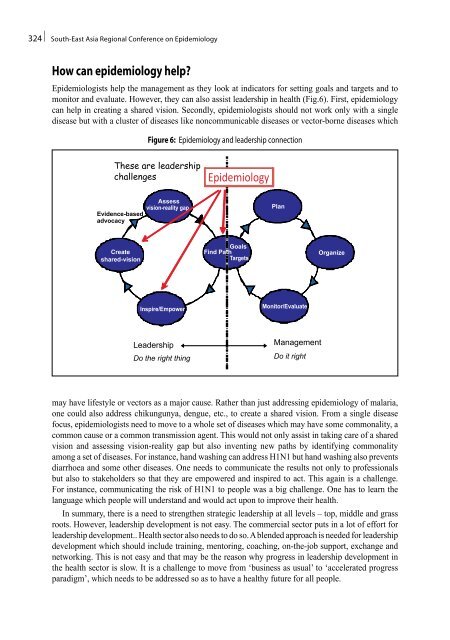South-East Asia Regional Conference on Epidemiology
South-East Asia Regional Conference on Epidemiology
South-East Asia Regional Conference on Epidemiology
Create successful ePaper yourself
Turn your PDF publications into a flip-book with our unique Google optimized e-Paper software.
324 | <str<strong>on</strong>g>South</str<strong>on</strong>g>-<str<strong>on</strong>g>East</str<strong>on</strong>g> <str<strong>on</strong>g>Asia</str<strong>on</strong>g> <str<strong>on</strong>g>Regi<strong>on</strong>al</str<strong>on</strong>g> <str<strong>on</strong>g>C<strong>on</strong>ference</str<strong>on</strong>g> <strong>on</strong> <strong>Epidemiology</strong><br />
How can epidemiology help?<br />
Epidemiologists help the management as they look at indicators for setting goals and targets and to<br />
m<strong>on</strong>itor and evaluate. However, they can also assist leadership in health (Fig.6). First, epidemiology<br />
can help in creating a shared visi<strong>on</strong>. Sec<strong>on</strong>dly, epidemiologists should not work <strong>on</strong>ly with a single<br />
disease but with a cluster of diseases like n<strong>on</strong>communicable diseases or vector-borne diseases which<br />
Figure 6: <strong>Epidemiology</strong> and leadership c<strong>on</strong>necti<strong>on</strong><br />
may have lifestyle or vectors as a major cause. Rather than just addressing epidemiology of malaria,<br />
<strong>on</strong>e could also address chikungunya, dengue, etc., to create a shared visi<strong>on</strong>. From a single disease<br />
focus, epidemiologists need to move to a whole set of diseases which may have some comm<strong>on</strong>ality, a<br />
comm<strong>on</strong> cause or a comm<strong>on</strong> transmissi<strong>on</strong> agent. This would not <strong>on</strong>ly assist in taking care of a shared<br />
visi<strong>on</strong> and assessing visi<strong>on</strong>-reality gap but also inventing new paths by identifying comm<strong>on</strong>ality<br />
am<strong>on</strong>g a set of diseases. For instance, hand washing can address H1N1 but hand washing also prevents<br />
diarrhoea and some other diseases. One needs to communicate the results not <strong>on</strong>ly to professi<strong>on</strong>als<br />
but also to stakeholders so that they are empowered and inspired to act. This again is a challenge.<br />
For instance, communicating the risk of H1N1 to people was a big challenge. One has to learn the<br />
language which people will understand and would act up<strong>on</strong> to improve their health.<br />
In summary, there is a need to strengthen strategic leadership at all levels – top, middle and grass<br />
roots. However, leadership development is not easy. The commercial sector puts in a lot of effort for<br />
leadership development.. Health sector also needs to do so. A blended approach is needed for leadership<br />
development which should include training, mentoring, coaching, <strong>on</strong>-the-job support, exchange and<br />
networking. This is not easy and that may be the reas<strong>on</strong> why progress in leadership development in<br />
the health sector is slow. It is a challenge to move from ‘business as usual’ to ‘accelerated progress<br />
paradigm’, which needs to be addressed so as to have a healthy future for all people.









